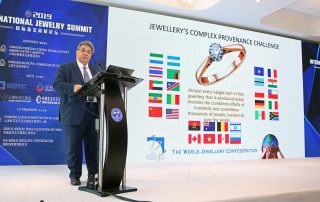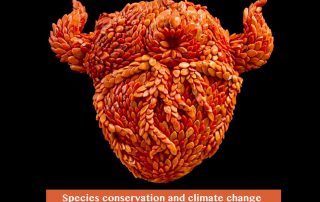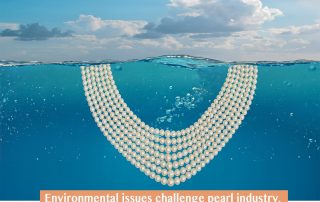About Steven Benson
This author has not yet filled in any details.So far Steven Benson has created 302 blog entries.
CIBJO President delivers keynote address on traceability standards at jewellery summit during Chinese Import Expo
ABOVE: CIBJO President Gaetano Cavalieri delivering the keynote address at the International Jewellery Standardisation Summit, which was held during the Second Chinese Import Expo in Shanghai on November 8, 2019.
NOVEMBER 11, 2019
CIBJO President Gaetano Cavalieri has delivered the keynote address at the International Jewellery Standardisation Summit in Shanghai on November 8, 2019, which was held in parallel with the Second China International Import Expo that is taking place in the city. In his address, he focused on the importance of origin traceability standards for the future of the jewellery sector, focusing specifically on their significance for the growth of the business in China.
The summit was coorganized by the China Gem & Jade Exchange, which recently joined CIBJO as a national association member. It was one a number of conferences being held during the China International Import Expo, in which the Chinese government is seeking to promote the opening of the giant Chinese market to the international trade.
Full traceability is very difficult in the jewellery sector, and is generally limited to a small number of companies that control the full range of production, from the mine through retail, the CIBJO President said. There are also a growing number of technological solutions, many of them using blockchain, where every time a gemstone, jewellery component or full item of jewellery changes hands, the transfer of ownership or custody is recorded.
“These are all exciting developments, but currently they are effective with only a small number of the materials flowing through the chain of distribution,” Dr. Cavalieri said. “Consequently, if we are going to talk about systems that encompass the bulk of materials that we handle, we have to look for administrative solutions. This means creating paper trails, or more appropriately for the world in which the live, digital trails.”


CIBJO President Gaetano Cavalieri being recognized by Simon Chen, Executive Vice President of the China Gems & Jade Excgange, during the International Jewellery Standardisation Summit in Shanghai on November 8, 2019.
“What we essentially are talking about is doing due diligence. In other words, carrying out a series of acts that essentially verify that all the parties supplying you have also done the appropriate due diligence,” he continued.
Describing a number of the existing due diligence systems being used in the industry, including those mandated by law, like the Kimberley Process Certification Scheme, national Anti-Money Laundering (AML) regimes, the Dodd Frank Act the European Union’s conflict minerals regulations, as well other industry enforced systems, some of which require third-party auditing, Dr. Cavalieri introduced CIBJO’s new Responsible Sourcing Blue Book of standards and guidelines, which was approved at the beginning of this year.
“Like the other CIBJO Blue Books, the standards and guidelines contained in the proposed CIBJO Responsible Sourcing document are recommendations, as opposed to conditions of membership,” he stated. “However, they should come to serve as benchmarks for responsible sourcing systems developed and applied by industry organisations and commercial bodies worldwide, and by governments.”
“An operating principle of the Responsible Sourcing document is that it will be inclusive, meaning that there is an expectation that the standards, guidelines and systems that it describes can reasonably be applied by all members of the industry, irrespective of size or financial capacity, Dr. Cavalieri stressed.
“Does this trace every component in an item of jewellery back to that specific part of the world in which it was sourced?” Dr. Cavalieri asked.
“No, it does not, and given the structural complexities of an industry such as ours, it is unlikely that any such system, covering most if not all the jewellery in the value chain, will ever be created,” he said. “But what it does is help create system by which every participant becomes a link in a chain of trust. Together we provide the commitment to integrity that our consumers require. This will work on one condition, and that is we all play our part. And to that we need common standards, which apply in China, as they do in Italy, or in any other part of the world.”
CIBJO releases Coral Special Report, focuses on global warming effects and conservationism
‘Heart,’ carved from Mediterranean Coral (Carallium rubrum) by Jan Fabre. From the Liverino Collection, Torre del Greco, Italy. It was the first time that coral was used as a primary medium in a contemporary piece by the renowned artist. © Jan Fabre 2019
NOVEMBER 6, 2019
With fewer than two weeks to go to the opening of the 2019 CIBJO Congress in Manama, Bahrain, on November 18, 2019, the ninth and the last of this year’s CIBJO commission Special Reports has been released. Prepared by the CIBJO Coral Commission, headed by Vincenzo Liverino, the report is dominated by environmental topics, and in particular the efforts by the industry to address the impact of global warming. It also reports on the worldwide effort to protect biodiversity and the various coral species.
As the report notes, no precious coral species are considered endangered by CITES, the Convention on International Trade in Endangered Species, although four varieties are listed in Appendix III, which requires the relevant authorities in each country to determine that specimens were acquired legally. The four Appendix III-listed precious coral species are Aka or Oxblood coral (Corallium japonicum), which lives in Japanese waters; Momo or Angel’s Skin coral (Pleurocorallium elatius), which can be found off the coasts of Japan and Taiwan; Pure White or Shiro coral (Pleurocorallium konojoi), which lives in Vietnamese waters; and Midway coral (Corallium secundum), which lives mainly off the coast of the U.S. State of Hawaii.
In the report, Mr. Liverino writes about a CIBJO initiative involving the identification of precious coral species using new DNA sequencing technology. This is being done in cooperation with the Federico II University in Naples, Italy, and in particular with the support of Professor Di Cosmo. DNA fingerprinting, the Coral Commission President explains, will allow members of trade to comply with current environmental legislation and international regulations, and also to meet conservationist concerns in the consumer markets.
The special report also discusses carbon-14 dating of precious coral and a range of educational tools that have been developed by the Coral Commission for use in the industry.
Concluding the report, Mr. Liverino urges members of the sector to sign on to CIBJO’s Jewellery Industry Greenhouse Gas Measurement Initiative, as part of the worldwide effort to address the devastating effects of global warming. “It is essential that industry recognize that carbon neutrality requires more than simply awareness, but actions as well. Carbon auditing is a first step and the CIBJO initiative in an important support mechanism,” he writes
To download a full copy of the CIBJO Coral Commission’s special report, PLEASE CLICK HERE.
CIBJO releases Pearl Special Report, looks at environmental challenges and opportunities
OCTOBER 30, 2019
With fewer than three weeks to go to the opening of the 2019 CIBJO Congress in Manama, Bahrain, on November 18, 2019, the eighth of the CIBJO commissions’ Special Reports has been released. Prepared by the CIBJO Pearl Commission, headed by Kenneth Scarratt, it looks at the growing impact of environmental and conservationist factors on the pearl sector, noting that these pose challenges but also provide opportunities for the industry.
A case in point is the Philippines, where Mr. Scarratt notes that climate and environmental changes have had a significant effect on pearl production. These relate to greater fluctuations in water temperature, ocean acidification, and the changing of the plankton profile, which has affected the survival rate of certain batches of oysters, as well as the overall growth rate.
“These changes present both challenges and opportunities. Obviously, the main challenge is the lower volume of production that will be available for distribution to the global market. On the other hand, this also serves as an opportunity because, with the lower biomass density, comes the potential to achieve a higher quality output,” he notes.
The report also looks at natural pearls. While rare, nowadays they most commonly are a by-product of the seafood industry, and in this respect could be subject to restrictions imposed by the Convention on International Trade in Endangered Species of Wild Fauna (CITES), as is the case with the Queen conch, off the coast of Mexico.
One country where fishing specifically for natural pearl-producing oysters still takes place is Bahrain, the venue of 2019 CIBJO Congress. The waters around the island nation have been producing natural pearls for some 4,000 years and continue to do so to this day, in a variety of sizes, shapes, and colours, writes Mr. Scarratt, who also notes that this is the only type of pearling that takes place in the kingdom.
The oyster variety located off the waters of Bahrain is Pinctada radiata, which is the same type of oyster being used to culture pearls at two facilities in the United Arab Emirates. A consequence of the production from the UAE is that one should no longer automatically assume that a pearl’s Pinctada radiata origin determines that it is natural, Mr. Scarratt notes.
To download a full copy of the CIBJO Pearl Commission’s special report, PLEASE CLICK HERE.




